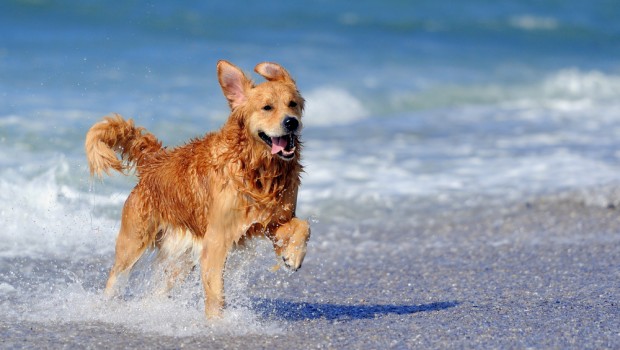Pet Activity Tracker For Your Dog
Thinking of buying a pet activity tracker for your dog? Here is some information that may help you make the right decision.
What Is A Pet Tracker?
A pet tracker is an electronic device that is located on a pet collar (or is part of the collar itself). It is used for two main purposes.
i) To locate your pet when it is out in the open.
ii) To track your pet’s daily activity. Like walking distance, sleep patterns, play levels, and many others. (Like a human fitness tracker such as a Fitbit.)
In most cases, the owner uses a mobile app on the phone to receive information and data from the tracker.
The devices may come in many sizes. From a simple tag, about the size of a typical dog tag, to a large device that may encompass the entire collar.
Larger trackers contain more electronic components that offer better features. Features like real-time location tracking.
Larger trackers are usually designed for dogs, where they may wander further. But due to the size/weight of the tracking device, it may not be suitable for a small dog to carry without discomfort.
Dog Location Trackers
Location trackers are used for locating a dog’s current location. This is useful if the dog has wandered off from the owner’s line of sight. There are two different technology for location trackers. They affect the cost and size of the trackers.
Bluetooth Trackers:
These trackers use Bluetooth to communicate with the owner’s phone. It sends the dog’s location information to the phone.
Bluetooth has a limited range (about 100 meters). So Bluetooth trackers are useful for detecting if a dog has wandered off the immediate area (like a yard). But not for tracking a lost dog.
The big advantages of a Bluetooth tracker are its size and cost. There are fewer electronic components involved, so most are about the size of a regular dog tag. No cell service required. So there is no monthly cost. But some tracker providers may charge for other services.
Some providers will extend the distance of coverage by using a crowdsourced model. Sometimes called a ‘mesh network’. This is where the dog may be located if it is within range of another user with the same app on their phone. But, this is unreliable, as it is dependent on populated areas and dog owners with the same tag provider. (It is unlikely to find another owner standing around in the wood with the same app.)
GPS Trackers:
These trackers use the Global Position System (GPS) to locate a dog’s location. It has an accuracy of about 10 meters. Like your car’s navigation system, it can cover a wider range of areas.
GPS tracker is especially useful if a dog has a habit of running off and getting lost.
Due to the longer range of coverage, the tracker sends information using cell service. The owner receives the location via the phone. There is usually a monthly service cost (which can range from $10-$20 a month). The tracker may also use Bluetooth if is it within a short distance of the phone.
There are more electronic components involved in GPS trackers. Hence these trackers are bigger and more costly than Bluetooth only trackers.
Although rare, a tracker may fall off from the dog’s collar (or the collar may break and come off). It is not a replacement for traditional methods like a microchip. Or a dog tag with the owner’s information. All dogs should be microchipped and wear a dog tag.
Some location tracking providers also track the pet’s activity.
Dog Activity Trackers
Pet activity trackers track and measure the health of your dog. Daily activity (or lack of) from walking to running and even sleeping (like a human health tracker).
The dog’s daily activity information is usually stored in the tracker. They are uploaded or sync to the owner’s phone via Bluetooth.
Information provided varies from different providers. It may include the intensity of activity (walking vs running). The period of activity. Or possibly the early sign of health issues due to unusual activity patterns.
These trackers are the size of a dog tag (if they do not include GPS tracking) and cost below $100.
What To Look For In A Pet Activity Tracker?
There are over 50 companies in the USA providing trackers for dogs. So there are many choices for the dog owner.
Tracker technology is advancing and providers are regularly updating and improving features. To take full advantage of a tracker’s features, the dog owner should own a recent model of a phone (no older than 4 years).
If runaway dogs are a concern, then GPS tracker is an option. Especially in a less populated area where a dog can wander without meeting a good samaritan. It provides peace of mind. Expect to spend $150-$200 on the tracker and approximately $100-$200 a year on yearly service fees.
GPS trackers are only effective if there is good cell service coverage. It is dependent on it to send the information back to the owner’s phone. GPS trackers have a shorter battery charge life, so prepare to charge at least once a week. Due to the size and weight of a typical GPS tracker, they may not be suitable for smaller dogs.
Activity trackers are great for monitoring your dog’s general health. Provide great insights into your dog’s daily life. These trackers need less maintenance, some have a battery life of 6 months. They can store activity information for up to 7 days before requiring an upload/sync.
Pet activity only trackers are also a cheaper option than GPS trackers, expect to pay no more than $90. Almost all have no monthly service fees. Activity trackers may also include Bluetooth location tracking. These trackers are a great option if you are concerned about the dog running away from the house or yard. They are not a good option if your sole concern is a lost dog. Where GPS tracking is a better solution as it provides a wider coverage area.
Many tracker providers claim they are 100% waterproof, this is misleading. For example, a dog cannot dive to the bottom of a lake with a tracker and expect it to be working. So look for ones that have at least an IPX6 or IPX7 waterproof rating. (These ratings means the tracker should withstand a splash on the beach or a quick dip in a shallow lake).






